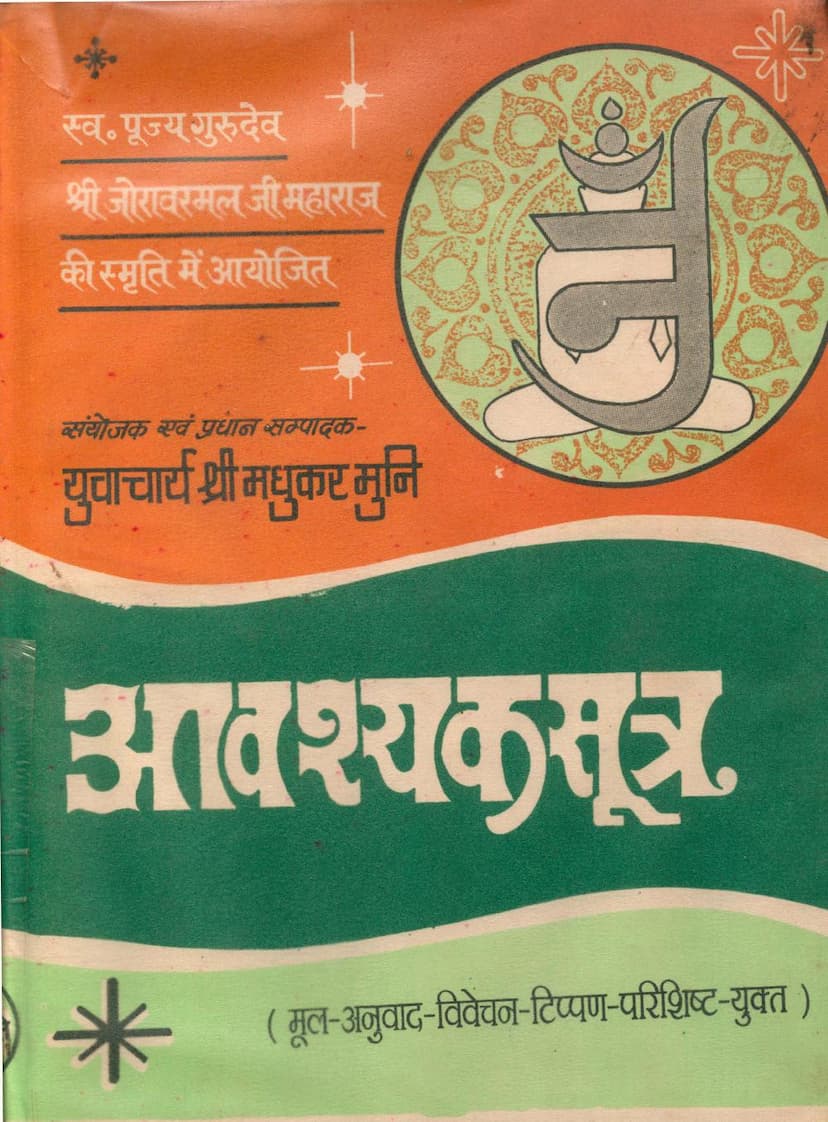Agam 28 Mool 01 Avashyak Sutra Stahanakvasi
Added to library: September 1, 2025

Summary
Here's a comprehensive summary of the Jain text, Agam 28 Mool 01 Avashyak Sutra, based on the provided pages:
Book Title: Agam 28 Mool 01 Avashyak Sutra Authors: Madhukarmuni, Shobhachad Bharilla, Mahasati Suprabha Publisher: Agam Prakashan Samiti Catalog Link: https://jainqq.org/explore/003464/1
This publication, "Avashyak Sutra," is part of the Jinagam Granthmala series (volume 24) and is presented as a third edition, published in November 2001. It is dedicated to the memory of "Sw. Pujya Gurudev Shri Joravarmalji Maharaj" and is a tribute to the late "Yuvacharya Shri Mishrimalji Maharaj 'Madhukar'," who was the convener and founder editor.
Core Content and Significance:
The "Avashyak Sutra" is a fundamental Jain religious text that deals with essential religious practices and duties, making it indispensable for any aspiring spiritual seeker. The book provides the original text, a Hindi translation, detailed explanations (vivechan), critical notes (tippan), and appendices.
Key Themes and Sections:
The book is structured around the concept of the Shad-Avashyak (Six Essentials), which are considered the core spiritual disciplines for both monks (shraman/shramani) and lay followers (shravak/shravika) in Jainism. These are:
-
Samayik (सामायिक): This is the foundational practice, emphasizing the cultivation of equanimity and equanimity of mind. It involves refraining from harmful (savajya) activities and focusing on pure (niravajya) ones. Samayik is described as the essence of Jain conduct and a vital step towards liberation. It teaches the equanimity of mind, controlling passions like anger, pride, deceit, and greed, and maintaining a balanced state of mind in happiness and sorrow.
-
Chaturvinshtistava (चतुर्विंशतिस्तव): This section focuses on the glorification and praise of the 24 Tirthankaras, who are considered the spiritual guides and exemplars. Their virtues are to be contemplated to inspire spiritual progress, purify one's understanding (darshan vishuddhi), and develop devotion.
-
Vandana (वंदना): This involves veneration and respect towards spiritual preceptors (gurus). It emphasizes humility (vinay) as the root of Dharma and highlights the importance of showing respect to those who possess superior knowledge and conduct. It is seen as a way to shed ego and foster a receptive attitude for spiritual learning.
-
Pratikraman (प्रतिक्रमण): This is a crucial practice for self-introspection and purification. It involves acknowledging and repenting for any lapses or transgressions (ativachar) committed in one's vows and spiritual practices. Pratikraman is described as a remedy for the "diseases of the mind" like anger, pride, deceit, and greed. It's a process of self-correction and seeking forgiveness, both internally and from the Guru. The text details five types of Pratikraman based on time (daily, nightly, fortnightly, four-monthly, yearly) and lists various types of faults to be confessed.
-
Kayotsarg (कायोत्सर्ग): Literally meaning "renunciation of the body," this practice involves detachment from the body and its sensations. It's a form of meditation or penance where one stands or sits still, controlling body movements and mind, aiming to overcome bodily attachment and focus on the pure soul. It's considered a vital "wound healing" practice for spiritual faults. The text discusses different ways and purposes of Kayotsarg.
-
Pratyakhyan (प्रत्याख्यान): This involves the vow of renunciation or undertaking specific vows of abstinence. It's essential for controlling desires (ichha) and preventing future transgressions. By limiting one's consumption and desires, one moves towards detachment and inner peace. The text outlines various types of Pratyakhyan and their respective durations and conditions.
Structure and Content Breakdown:
- Guru Vandana: The book begins with a prayer of reverence to the Guru, emphasizing their paramount importance in spiritual guidance.
- Namaskar Sutra: The Navkar Mantra (Panch Namaskar) is presented as the most sacred and powerful mantra in Jainism, considered the essence of all scriptures and a potent purifier. Its verses and their significance are explained.
- Mangal Sutra & Uttam Chatustay: The text discusses the concept of auspiciousness, differentiating between worldly and spiritual (lokottar) auspiciousness, highlighting the Tirthankaras, Siddhas, Sadhus, and Dharma as the ultimate auspicious entities.
- Sharan Sutra: It emphasizes taking refuge in the Tirthankaras, Siddhas, Sadhus, and Dharma as the true and eternal refuge in life.
- Detailed Analysis of Each Avashyak: The bulk of the text is dedicated to explaining each of the six essential practices in detail, drawing upon various Jain scriptures like the Agam Sutras, Niyukti, Bhashya, Churni, and Vrittis.
- Scholarly Commentary and References: The explanations are enriched with references to earlier Jain commentaries and philosophical texts, showcasing a deep engagement with the tradition. The language used is primarily Hindi, with explanations of specific Sanskrit and Prakrit terms.
- Comparisons with Other Traditions: The text also draws parallels and contrasts between Jain practices like Samayik and those found in Buddhism and Vedic traditions, highlighting the universal spiritual principles of equanimity and self-discipline.
- Purpose of the Text: The "Avashyak Sutra" aims to provide a comprehensive understanding and practical guidance for followers to implement these essential daily practices, leading to spiritual purification, ethical conduct, and ultimately, liberation.
- Editorial and Publishing Information: The book lists the various individuals and committees involved in its publication, including the inspiring souls, editors, translators, and publishers, indicating a collaborative effort to disseminate Jain knowledge.
In essence, this publication serves as an in-depth guide to the fundamental Jain practices, explaining their philosophical underpinnings, practical application, and profound spiritual benefits for the adherent.